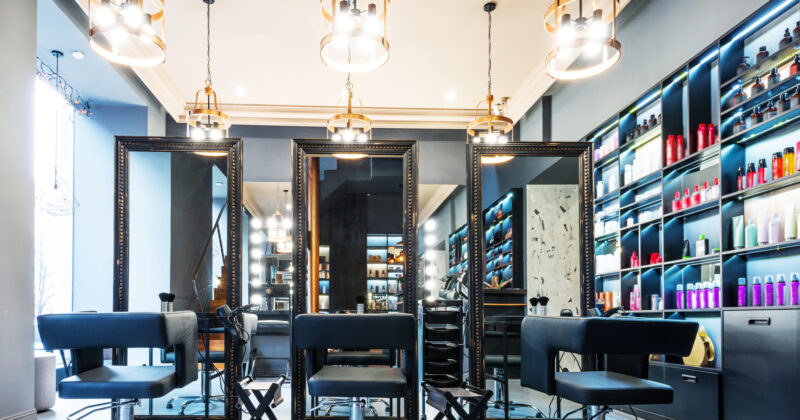When it comes to running a successful salon, a stunning online presence can make all the difference. From attracting new clients to showcasing your services, an engaging and visually striking salon website is essential. Whether you specialize in hair treatments, nail artistry, or a full-service experience, your website sets the tone for everything that comes next. It should reflect the personality of your brand while providing straightforward information about your salon’s location, services, and pricing.
Salons of every kind use the web to reach clients before they ever walk through the door. And with the right salon website design, you can give visitors a taste of your unique approach. Today’s best salon websites show off their stylists’ work, feature simple online booking, and highlight the welcoming environment customers can expect. From vibrant color schemes to user-friendly layouts, these sites prove that investing in top-notch design goes a long way in the highly competitive beauty industry.
Finally, a well-executed hair salon website or nail salon website sets you apart from other salon websites by showcasing your specialties and establishing your credibility. In an industry that often relies on word-of-mouth, a powerful web presence can expand your reach and help you stay relevant in a fast-changing market. Let’s explore some exemplary designs that stand out from the crowd.
Examples of the Best Salon Website Designs
- Mèche Salon: Mèche Salon in Los Angeles boasts a luxurious online presence that reflects its upscale approach to hair styling. Their website blends a streamlined layout with high-quality images of stylish hair transformations, reinforcing their reputation for excellence. Large photos create a glossy, magazine-like feel, while the site’s organized navigation bars guide users to services, stylists, and pricing details with ease. A cleverly integrated booking tool enables visitors to schedule appointments with ease. Mèche’s online ambiance speaks volumes about the expertise you can expect from the salon, exemplifying why a well-designed salon website is crucial in today’s market.
- Ouidad: Ouidad specializes in curly hair care, and its website makes this specialty clear from the start. By highlighting before-and-after galleries of curly styles, Ouidad captures visitors’ attention and shows off their expert stylists. The clean navigation simplifies the exploration of products, services, and educational resources. Soft color schemes and eye-catching fonts reinforce a welcoming, modern feel. Visitors can find personalized curl solutions, learn about different hair treatments, and schedule appointments all within a few clicks. The design perfectly reflects the brand’s focus on natural beauty, proving how vital it is for a salon website design to match the brand’s identity.
- Madison Reed: Madison Reed might be known for hair color products, but its salon services and Color Bars are also showcased impeccably on its user-friendly site. The homepage features modern visuals and an interactive color selection tool, catering to those looking to find their perfect hair shade. Easy click-through options guide potential customers to the nearest salon location, boosting foot traffic. The site emphasizes the brand’s mission for healthier, high-quality hair color, appealing to modern consumers seeking cruelty-free or ammonia-free options. This sophisticated hair salon website demonstrates how to focus on both e-commerce and in-person appointments without losing clarity or style.
- Drybar: Drybar’s website embodies the brand’s playful personality and bright-yellow aesthetic in every corner. From the moment you land on the homepage, you feel the energetic vibe that defines the salon’s blowout experience. Easy navigation leads visitors to book an appointment, buy products, or locate the nearest store. Crisp product images and concise service descriptions help visitors understand the offerings right away. Their online presence expertly illustrates how brand consistency can support an unforgettable salon experience. For salon owners, Drybar’s example showcases why color palette and design elements matter to create a memorable digital impression.
- Blo Blow Dry Bar: Blo Blow Dry Bar’s website gives visitors a quick overview of their specialized services while capturing an element of fun. Vibrant pink and white hues energize the layout, giving a friendly, inviting feel. Subtle animations guide the eye across the page, and minimal text keeps the layout free of clutter. The salon finder tool connects customers to local branches, making appointment scheduling a snap. By spotlighting a membership program and promotions, Blo’s site effectively channels returning business. This approach emphasizes how salon websites can be designed to keep loyal clients engaged and excited about new services.
- Great Clips: Great Clips prioritizes convenience, and its website reflects this commitment with a user-friendly design and integrated check-in feature. Visitors can view wait times at local salons, allowing them to plan their visit efficiently. Bold imagery highlights standard styling services, while the “Offers” section provides easy access to current promotions. The site also features an online profile that allows users to save their favorite salon locations, demonstrating how personalization can become a marketing advantage. Great Clips offers a prime example of how to blend informative content with practical features that match the brand’s “quick and easy” reputation.
- Toni & Guy: Toni & Guy is an international powerhouse in hair fashion, and their website establishes that prestige right away. The homepage welcomes visitors with high-fashion editorial imagery, reflecting the salon’s cutting-edge approach. Clear site sections guide you through styling inspirations, educational opportunities, and product lines. The design leans on a monochromatic palette, emphasizing sleek visuals that mirror a runway or fashion magazine. Booking details, salon locations, and stylist profiles are organized clearly, enhancing the user experience. If you’re aiming for a bold, modern concept, Toni & Guy’s website is a showcase of fashion-forward salon website design.
- Sassoon Salon: Sassoon Salon’s site embraces a minimalist aesthetic to highlight sophisticated hairstyles and brand heritage. The black-and-white theme, complemented by high-definition hair shots, underscores the salon’s refined approach. Smooth scrolling transitions guide users seamlessly from brand history to stylist portfolios—educational content on hair treatment tips positions Sassoon as a thought leader in the salon world. Contact and booking buttons are strategically placed to encourage client engagement. Every design element points back to the brand’s premium feel, providing an outstanding example of how a clean, polished look can effectively attract a high-end clientele.
- Aveda: Aveda’s website exudes wellness and sustainability, aligning with the company’s mission to provide eco-friendly products and salon services. Earthy tones and nature-inspired imagery set a calming atmosphere from the start. Navigation is intuitive, leading users to explore salon locations, holistic haircare tips, and the brand’s organic product range. The site’s content-driven approach includes articles on self-care and beauty trends, fostering client trust and loyalty. Aveda’s success highlights the importance of strong brand storytelling, combined with a well-structured website, in informing potential customers about your core values and ultimately enhancing your position in the competitive salon industry.
- Murdock London: Murdock London caters to men’s grooming, and their website channels a classic yet modern aesthetic. Clean lines, plenty of white space, and vintage-inspired typography create a refined environment. Featured products and services revolve around traditional barbering techniques, but the site keeps up with modern demands through appointment scheduling and online shopping. Personal grooming tips and blog posts add value and drive user engagement. By focusing on a specific audience—gentlemen who want a premium grooming experience—Murdock London illustrates how niche salons can craft a digital experience aligned perfectly with their brand personality.
- Pophair: Its website uses sleek design elements and vibrant photography to capture attention immediately. Their homepage showcases stylists at work, with bold call-to-action buttons to book appointments or learn about current promotions. Offering both hair and beauty services, Pophair effectively organizes each category for easy navigation. The color palette—relying on blacks, whites, and pops of bright color—adds a fashionable edge without overwhelming visitors. This blend of visual storytelling, brand-specific aesthetics, and transparent service information ensures that customers know exactly what to expect before stepping into the salon.
- Fox & Jane Salon: Fox & Jane Salon’s website prioritizes friendliness and simplicity. Warm images welcome visitors, while large text and minimal clutter provide a straightforward way to browse services and locations. Online booking is clearly visible, eliminating friction for prospective clients. Each salon location has its own dedicated page, with staff bios and a gallery showcasing real results. Their approach humanizes the brand, presenting stylists as approachable experts who value client relationships. Fox & Jane’s site shows how balancing aesthetics and usability can deliver a polished, inviting digital platform for both new and returning guests.
- Fringe Hair Art: Fringe Hair Art’s website embraces a down-to-earth vibe, focusing on the personal touch their stylists provide. High-resolution shots of real clients dominate the homepage, adding authenticity. The site’s design is intuitive, guiding users from the homepage to the service menu and an “About” section that outlines the salon’s creative philosophy. Subtle color accents highlight the brand’s personality without overshadowing the main content. Fringe Hair Art also includes links to social media, showcasing stylists’ portfolios in real-time. This interactive design approach builds trust and encourages online visitors to book appointments.
- The Beauty Box Salon: The Beauty Box Salon integrates informative content and stylish visuals to position itself as a leader in hair extensions and color services. Immediately, the viewer sees imagery of transformations alongside clear call-to-actions to “Contact Us” or view services. The blog section delves into trend reports and beauty tips, converting curious browsers into knowledgeable clients. The site’s structured layout also underscores expertise, with a gallery detailing client successes and an FAQ page addressing common concerns. Overall, the Beauty Box Salon exemplifies how well-organized, educational content combined with purposeful design can highlight a salon’s niche specialization.
- Hairroin Salon: Hairroin Salon’s edgy, urban-inspired website appeals to those who want a more offbeat beauty experience. Bold type, artistic imagery, and a darker color scheme establish a modern, cool aesthetic. Stylists are front and center, with dedicated bios and galleries that highlight their individual flair. The site walks visitors through each location’s services and amenities, helping them pick the right salon before they book. A dedicated product section adds e-commerce features, while the blog keeps content fresh and relevant. It’s an excellent example of how an online platform can amplify a salon’s unique brand story.
- Bumble and bumble: Bumble and bumble began as an NYC salon and evolved into a global haircare brand, which their website represents beautifully. The site’s editorial feel showcases high-fashion hairstyles and behind-the-scenes looks at photoshoots. Strong calls-to-action guide potential clients to explore professional services or products, blending e-commerce and salon booking in a single platform. Web design elements echo the brand’s reputation for creativity and experimentation. By weaving lifestyle imagery with precise service details, Bumble and Bumble exemplifies how a premium salon can maintain its avant-garde image while still offering user-friendly navigation for clients of all backgrounds.
- Luxe Concept Hair Salon: Its website delivers a polished and luxurious digital experience that mirrors the high-end services offered at its Chatswood Chase location. The homepage features elegant visuals and a refined color palette, creating an inviting atmosphere for visitors. Navigation is intuitive, with clearly labeled sections guiding users through services, stylist profiles, and a comprehensive product shop. The inclusion of detailed service descriptions, such as hair coloring packages and specialized treatments, allows clients to make informed decisions. Customer testimonials and a gallery of the stylist’s work further enhance credibility and showcase the salon’s expertise.
- Nine Zero One Salon: Nine Zero One Salon elevates Hollywood glam with a site that’s as star-studded as its clientele. Celebrity hairstyling images, vibrant backgrounds, and elegant fonts create a glamorous feel from the start. Online booking is accessible, with an emphasis on exclusive services like color correction and extensions. The site also features a “Press” section that highlights media appearances, reinforcing the salon’s high-profile reputation. With a logical, organized layout, Nine Zero One successfully merges luxury appeal with a straightforward user experience, demonstrating how a nail salon website or hair salon platform can dazzle without sacrificing clarity.
- Van Michael Salon: Van Michael Salon underscores its award-winning status right on the homepage with eye-catching accolades and press features. This strategy instantly builds credibility and informs visitors about the salon’s expertise. The site uses soft neutral colors that complement high-quality images of contemporary hairstyles. A strong emphasis on hair cutting, coloring, and signature services appeals to clients seeking a complete beauty experience. The easy-to-use navigation and clear information on each location’s stylists simplify the decision-making process. This well-balanced design shows how gently integrating accolades can enhance a site’s reputation and build visitor confidence.
- Hair & Co BKLYN: Its website offers a vibrant and user-friendly experience that reflects the salon’s creative energy and commitment to individuality. The homepage welcomes visitors with bold typography and a warm, inviting message—“We Want to Make You Smile”—setting a tone that is both welcoming and engaging. Navigation is intuitive, with clearly labeled sections for services, team profiles, and booking options, making it easy for clients to find the information they need. The site highlights their expertise in diverse hair types, particularly in caring for textured and curly hair, showcasing their inclusive approach to hair care. Features like the stylist matchmaking quiz and detailed service descriptions enhance user engagement and personalization.
A strong digital presence can boost your salon’s visibility, enhance credibility, and encourage new clients to book services. As these examples demonstrate, the best salon websites combine aesthetic flair, user-friendly features, and brand-consistent visuals to leave a lasting impression. Whether you run a hair salon website or a nail salon website, tailoring design elements to match your salon’s values and client expectations is key.
From highlighting high-quality images of your work to embedding straightforward appointment booking, investing in superior design pays off. Give your visitors a sneak peek into the unique experience you offer, complete with testimonials, staff profiles, and a glimpse of your salon’s atmosphere. When you place user experience at the forefront of your salon website, you make it easier for prospective clients to say “yes” and schedule a visit.
Remember, simplicity and authenticity create the best foundation for any salon website design. Keep your brand identity consistent, provide relevant information, and always consider how a potential customer will interact with your site. With the right approach, your salon’s online platform can be as stylish as the transformations you offer.
Top 10 Most Important Aspects of a Salon Website
- High-Quality Imagery: Showcasing your salon’s work with clear, professional photos is crucial. Clients want to see evidence of your styling skills before booking.
- Online Booking: A direct scheduling tool saves time and offers seamless access for both new and returning clients.
- Service Menu: Clearly outline each service, along with pricing, so clients know exactly what to expect and can budget accordingly.
- Brand Consistency: From the color palette to the tone of your copy, every element should reinforce your salon’s unique identity.
- Location & Contact Details: Make your address, phone number, and hours easily accessible to boost in-person visits and phone inquiries.
- Responsive Design: Ensure the site is just as appealing and functional on mobile devices, where many customers research salons.
- Staff Highlights: Featuring stylist profiles and expertise can personalize your salon and foster trust with potential clients.
- Client Testimonials: Authentic reviews or video testimonials help establish credibility and differentiate you from competitors.
- Easy Navigation: User-friendly layout and well-labeled menus create a smooth experience for visitors, encouraging them to explore more.
- Strong Call-to-Action: Prompt users to book an appointment, explore specials, or sign up for a newsletter, ensuring they engage and return.
FAQs About Salon Web Design
How can I make my salon website stand out from competitors?
Focus on showing off high-quality images of your salon and stylists’ work, and keep your design sleek, user-friendly, and true to your brand identity.
What platform is best for building a salon website?
WordPress is typically a top choice due to its flexibility, user-friendly interface, and vast library of customizable themes and plugins tailored to salons.
How much does it typically cost to design a salon website?
Basic websites can begin around $2,000 and increase from there based on features like e-commerce, booking systems, and advanced styling or branding.
How often should I update my salon website?
You should update your site whenever you have meaningful new content, such as fresh services or promotions. Regular changes should add value for visitors, not just for search engines.
Why are salon websites vital for my business?
They serve as a digital storefront, showcasing your services and style while making it simple for new clients to find you and book appointments.
Ready to elevate your salon’s website? Contact CyberOptik for a free proposal for your new salon website design and set your business up for success.




